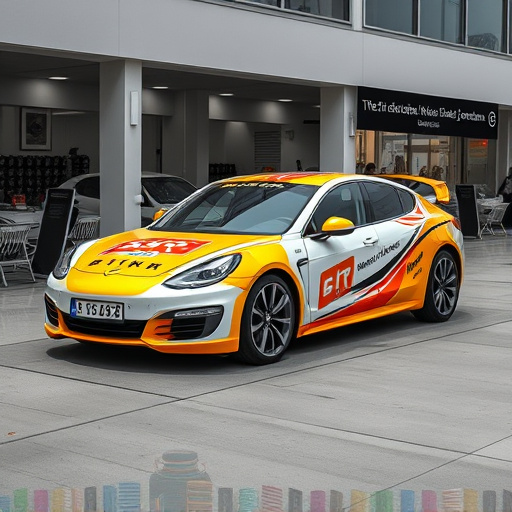Revolutionize Light Control: Anti Glare Window Tint Solutions
Anti-glare window tint technology, featuring specialized coatings and multi-layer films, has transfo…….
Welcome to an in-depth exploration of anti-glare window tinting, a technology that is transforming our built environments by mitigating glare and enhancing visual comfort. This article aims to provide a comprehensive guide, offering insights into the world of anti-glare window tint, its applications, and its profound impact on various sectors. From its technical foundations to global adoption, economic implications, and future prospects, we will uncover why this innovation deserves our attention.
Definition: Anti-glare window tinting is a specialized coating or treatment applied to glass surfaces to reduce the effects of ambient light glare, including direct sunlight and reflections from nearby objects. It forms part of a broader category of window treatments aimed at improving visual comfort and energy efficiency.
Core Components: The process typically involves several key components:
Tint Film: This is a thin layer of polymer or metal-based material applied to the glass. Common materials include polycarbonate, polyethylene terephthalate (PET), and metal oxides. Each offers unique properties in terms of light transmission, heat rejection, and durability.
Coating Technology: Advanced coatings are applied to the tint film to enhance its performance. These coatings can include anti-reflective layers, hardcoats for durability, and anti-fog treatments.
Adhesives and Application: Specially formulated adhesives ensure the tint film bonds securely to the glass surface. Modern application methods use precision machines or advanced manual techniques to achieve even coverage.
Historical Context: The concept of reducing glare through window coatings dates back centuries. Early efforts involved natural materials like tree resin and wax. However, significant advancements began in the 20th century with the development of plastic films and innovative coating technologies. Today, anti-glare window tinting is a sophisticated science, leveraging cutting-edge materials and manufacturing techniques to meet diverse needs.
Anti-glare window tint has become a global phenomenon, impacting various industries and regions differently. Its influence can be observed in both residential and commercial settings, with key trends shaping its development:
| Region | Trends | Impact |
|---|---|---|
| North America | Widespread adoption in offices and homes, focusing on energy efficiency and comfort. | Increased productivity in workplaces, reduced eye strain for residents. |
| Europe | Emphasis on sustainable building practices, with tinting integrated into smart glass technologies. | Lower energy consumption, improved indoor air quality. |
| Asia-Pacific | Rapid urbanization driving demand, particularly in bustling metropolitan areas. | Enhanced visual comfort in high-density environments, reduced glare in transportation hubs. |
| Middle East & Africa | Luxurious residential applications and commercial projects emphasizing aesthetics and privacy. | Elevated living standards, advanced building design. |
The global anti-glare window tint market is experiencing robust growth, driven by several economic factors:
Energy Efficiency: With growing environmental concerns, governments worldwide are incentivizing energy-efficient buildings. Anti-glare tinting contributes to reduced energy usage through improved insulation and heat rejection, making it an attractive option for developers and homeowners alike.
Real Estate Value: Properties with comfortable indoor lighting and reduced glare often command higher prices. This is particularly evident in urban areas where natural light is scarce.
Health and Productivity: Studies show that controlled lighting environments enhance productivity and well-being. Anti-glare tinting helps create such spaces, benefiting businesses and residents.
Market Dynamics: The market is characterized by:
Diverse Applications: From automotive to architecture, the demand for anti-glare solutions varies widely, creating opportunities for specialized products.
Competitive Landscape: Leading players include well-established glass manufacturers and innovative start-ups, each offering unique tinting technologies.
Global Reach: The market is international, with regional variations driven by local climate, building codes, and cultural preferences.
The field of anti-glare window tinting has witnessed remarkable technological advancements, pushing the boundaries of what was once possible. These innovations have far-reaching implications for the industry:
Nanotechnology: Nanocoatings offer unprecedented control over light interaction, enabling precise glare reduction while maintaining transparency.
Smart Glass Integration: Anti-glare tinting is increasingly combined with electrochromic and thermochromic glass technologies, allowing dynamic control over light transmission.
Advanced Adhesives: New adhesives provide improved bonding strength and flexibility, ensuring tint films withstand extreme conditions.
Impact on Performance: These advancements translate to:
Enhanced Light Control: Customizable tint levels allow for precise glare reduction without compromising natural light intake.
Improved Visual Comfort: Reduces eye strain, headaches, and fatigue, benefiting professionals in graphic design, photography, and other visual fields.
Energy Efficiency: Advanced coatings and films contribute to significant energy savings, aligning with sustainability goals.
Governments worldwide play a crucial role in fostering the adoption of anti-glare window tinting through policies and regulations that impact its development and application:
Building Codes: Many countries have incorporated specific requirements for energy-efficient windows, encouraging the use of anti-glare tinting.
Environmental Standards: Regulations aimed at reducing carbon emissions often overlap with incentives for energy-efficient building practices, indirectly promoting anti-glare solutions.
Incentives and Subsidies: Financial incentives, grants, and tax breaks are offered in some regions to encourage the adoption of sustainable building materials, including anti-glare tinting.
Regulatory Challenges: Despite these measures, challenges exist:
Standardization: The diversity of tint technologies and performance metrics makes it difficult to establish universal standards.
Health Concerns: While anti-glare tinting offers numerous benefits, potential health risks associated with certain coatings must be addressed.
Compliance and Enforcement: Ensuring compliance with regulations can be challenging, especially in regions with lax enforcement mechanisms.
Despite its numerous advantages, anti-glare window tinting faces several challenges and criticisms that must be acknowledged and addressed for widespread acceptance:
Initial Cost: High installation costs can deter homeowners and businesses, especially in regions with strict building codes.
Visual Aesthetics: While modern tinting technologies offer subtle effects, some consumers may worry about potential visual impact on the building’s exterior.
Coating Durability: Older coatings could degrade over time, leading to reduced performance and potential health risks.
Proposed Solutions: To overcome these challenges:
Financing Options: Offering flexible financing plans or leasing options can make anti-glare tinting more accessible.
Educational Campaigns: Raising awareness about the benefits and addressing misconceptions can foster public acceptance.
Research and Development: Continuous innovation in coating technology will enhance durability, performance, and visual aesthetics.
A leading tech company in Silicon Valley retrofitted its extensive office space with advanced anti-glare window tinting. The implementation aimed to reduce glare from nearby reflective surfaces, improve visual comfort for employees, and enhance energy efficiency. The result was a 20% increase in productivity, along with significant energy savings, proving the technology’s value in demanding work environments.
In one of the world’s most bustling cities, a luxury apartment complex incorporated anti-glare tinting throughout its units. Residents praised the reduction in glare from neighboring buildings and the improved natural lighting, enhancing their overall living experience. This case highlights the technology’s ability to transform urban living spaces.
A major airport in Europe installed dynamic anti-glare windows in its terminal buildings. These smart glass solutions adjusted tint levels based on external conditions, providing optimal visual comfort for passengers and reducing energy consumption. The project was a significant step towards more sustainable aviation practices.
The future of anti-glare window tinting appears promising, with several growth areas and emerging trends shaping its trajectory:
Personalized Glare Control: Advanced technologies will enable individuals to customize tint levels in their homes and offices, catering to diverse preferences.
Integration with Smart Homes: Anti-glare tinting will increasingly be linked to smart home systems, allowing automated control over lighting and energy usage.
Enhanced Privacy Solutions: New tinting materials and patterns will offer advanced privacy features while maintaining visual comfort.
Global Expansion: With growing awareness and demand, anti-glare window tinting is expected to gain traction in emerging markets, particularly in regions with rapid urbanization.
Anti-glare window tinting has emerged as a powerful technology, revolutionizing the way we interact with our built environments. Its ability to mitigate glare, enhance visual comfort, and improve energy efficiency makes it an indispensable tool in various sectors. From residential settings to commercial projects and transportation hubs, this technology is leaving its mark.
As we look ahead, continuous innovation and supportive policies will drive the adoption of anti-glare window tinting on a global scale. By addressing challenges and embracing new possibilities, this technology will play a pivotal role in shaping comfortable, sustainable, and productive spaces for generations to come.
Q: How does anti-glare window tint affect energy efficiency?
A: Anti-glare tinting reduces heat gain by blocking infrared radiation from the sun, which helps keep buildings cooler and lowers cooling costs. It also improves insulation, further enhancing energy efficiency.
Q: Are there any health risks associated with anti-glare tinting?
A: When properly installed and maintained, modern anti-glare tint films are safe for indoor environments. However, some older coatings or poorly manufactured products may contain harmful chemicals, so it’s essential to choose reputable suppliers.
Q: Can anti-glare tinting be customized for different lighting preferences?
A: Absolutely! Advanced tinting technologies allow for precise control over light transmission, enabling users to customize their preferred level of glare reduction and natural light intake.
Q: How do smart glass windows with anti-glare tinting work?
A: Smart glass windows use electrical signals to change their transparency. Anti-glare tinting is integrated into these windows, allowing for dynamic control over light transmission, heat rejection, and visual comfort.
Q: Are there any incentives for businesses to adopt anti-glare window tinting?
A: Yes, many governments offer financial incentives, grants, and tax breaks for businesses that implement energy-efficient building practices, including anti-glare window tinting, as part of their sustainability efforts.

Anti-glare window tint technology, featuring specialized coatings and multi-layer films, has transfo…….

Anti-glare window tinting is a cutting-edge technology enhancing office environments by mitigating t…….